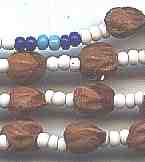Your path =Home>Beadmaking & Materials>Organic Materials> The Mouse
Seeds, a Mouse and a Bead Stringer
This story comes from Mary Musgrove of Des Moines Iowa, USA
and was included in a recent Margaretologist.
|
Some 20 years ago the Musgroves watched a Navajo boy take these seeds from a container of water, poke a hole into one end with a needle and string them. They brought some seeds home with them to try it themselves. The found that one end would soften, but the other end with the "cap" was too hard to pierce.
A year or two later, they found a mouse nest at Natural Bridges National Monument with lots of juniper seed coats. The mice had chewed off the hard "cap" and eaten the seed inside. The other end of the seed could be easily pierced after soaking. They believe that the Navajo boy had gathered his seeds from a mouse nest.
Warning: It would be foolhardy to do this today due to rodents in the area infected with Hanthavirus, which is quite dangerous to humans.
Three of the four seeds Mrs. Musgrove sent me look as though they had been pierced in this manner. However, most (but not all) seeds on a strand given the Center by Elizabeth Harris some years ago (above) had their caps cut with a metal tool.
It would take a lot of mice nests to provide enough seeds for beads, so liberally used in multiple strand necklaces. On the other hand, it's nice to know that sometimes a little rodent can assist a young bead stringer.
__________________________________________________
Small Bead Businesses | Beading & Beadwork | Ancient Beads | Trade Beads
Beadmaking & Materials | Bead Uses | Researching Beads | Beads and People
Center for Bead Research | Book Store | Free Store | Bead Bazaar
Shopping Mall | The Bead Auction | Galleries | People | Events
The Bead Site Home | Chat Line | Contact Us | Site Search Engine | FAQ
